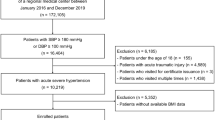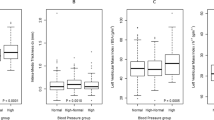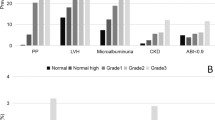Abstract
OBJECTIVE:
To examine the impact of overweight and obesity on development of target organ damage in the early stage of hypertension.
SUBJECTS:
Participants were 727 young-to-middle-age subjects screened for stage 1 hypertension and followed for 8 years.
MEASUREMENTS:
Ambulatory blood pressure (BP), albumin excretion rate and echocardiographic data were obtained at entry, every 5 years and/or before starting antihypertensive treatment.
RESULTS:
During the follow-up, hypertension needing treatment was developed by 54.7% of the subjects with normal weight, 66.6% of those with overweight and 73.0% of those with obesity (P<0.001). Kaplan–Meier curves showed that patients with obesity or overweight progressed to sustained hypertension earlier than those with normal weight (P<0.001). At study end, rate of organ damage was 10.7% in the normal weight, 16.4% in the overweight and 30.1% in the obese subjects (P<0.001). In a multivariable logistic regression analysis, overweight (P=0.008) and obesity (P<0.001) were significant predictors of final organ damage. Inclusion of changes in 24-h BP and body mass index, and of baseline organ damage did not virtually modify these associations (P=0.002 and <0.001, respectively). Obesity was a significant predictor of both left ventricular hypertrophy (P<0.001) and microalbuminuria (P=0.015) with an odds ratio (95% confidence interval) of 8.5 (2.7–26.8) and 3.5 (1.3–9.6), respectively.
CONCLUSION:
These data indicate that in hypertensive subjects obesity has deleterious effects on the cardiovascular system already at an early age. Preventive strategies addressed to achieve weight reduction should be implemented at a very early stage in young people with excess adiposity and high BP.
This is a preview of subscription content, access via your institution
Access options
Subscribe to this journal
Receive 12 print issues and online access
$259.00 per year
only $21.58 per issue
Buy this article
- Purchase on Springer Link
- Instant access to full article PDF
Prices may be subject to local taxes which are calculated during checkout



Similar content being viewed by others
References
Cutler JA, Sorlie PD, Wolz M, Thom T, Fields LE, Roccella EJ . Trends in hypertension prevalence, awareness, treatment, and control rates in United States adults between 1988–1994 and 1999–2004. Hypertension 2008; 52: 818–827.
Kotchen TA . Obesity-related hypertension: epidemiology, pathophysiology, and clinical management. Am J Hypertens 2011; 23: 1170–1178.
Timpson NJ, Harbord R, Davey Smith G, Timpson NJ, Harbord R, Davey Smith G . Does greater adiposity increase blood pressure and hypertension risk?: Mendelian randomization using the FTO/MC4R genotype. Hypertension 2009; 54: 84–90.
Narkiewicz K . Diagnosis and management of hypertension in obesity. Obes Rev 2006; 7: 155–162.
Viazzi F, Leoncini G, Adami GF, Papadia FS, Bezante GP, Conti N et al. Sub-clinical organ damage in hypertension and obesity. Nutr Metab Cardiovasc Dis 2011; 21: 597–602.
Kotsis VT, Stabouli SV, Papamichael CM, Zakopoulos NA . Impact of obesity in intima media thickness of carotid arteries. Obesity 2006; 14: 1708–1715.
Palatini P, Graniero G, Mormino P, Nicolosi L, Mos L, Visentin P et al. Relation between physical training and ambulatory blood pressure in stage I hypertensive subjects. Results of the HARVEST trial. Circulation 1994; 90: 2870–2876.
Sartori M, Semplicini A, Siffert W, Mormino P, Mazzer A, Pegoraro F et al. G-protein beta3-subunit gene 825T allele and hypertension: a longitudinal study in young grade I hypertensives. Hypertension 2003; 42: 909–914.
Palatini P, Mormino P, Dorigatti F, Santonastaso M, Mos L, De Toni R et al. Glomerular hyperfiltration predicts the development of microalbuminuria in stage 1 hypertension: the HARVEST. Kidney Int 2006; 70: 578–584.
Wang Y, Wang QJ . The prevalence of prehypertension and hypertension among US adults according to the new joint national committee guidelines: new challenges of the old problem. Arch Intern Med 2004; 164: 2126–2134.
Sahn DJ, Demaria A, Kisslo J, Weyman A . Recommendations regarding quantitation in M-mode echocardiography: results of a survey of echocardiographic measurements. Circulation 1978; 58: 1072–1083.
Devereux RB, Lutas EM, Casale PN, Kilgfield P, Eisenberger RR, Hammond IW et al. Standardization of M-mode echocardiographic left ventricular anatomic measurements. J Am Coll Cardiol 1984; 4: 1222–1230.
De Simone G, Daniels SR, Devereux RB, Meyer RA, Roman MJ, de Divitiis O et al. Left ventricular mass and body size in normotensive children and adults: assessment of allometric relations and impact of overweight. J Am Coll Cardiol 1992; 20: 1251–1260.
Palatini P, Visentin P, Dorigatti F, Guarnieri C, Santonastaso M, Cozzio S et al. Regular physical activity prevents development of left ventricular hypertrophy in hypertension. Eur Heart J 2009; 30: 225–232.
Winnicki M, Bonso E, Dorigatti F, Longo D, Zaetta V, Mattarei M et al. Effect of body weight loss on blood pressure after 6 years of follow-up in stage 1 hypertension. Am J Hypertens 2006; 19: 1103–1109.
Peduzzi P, Holford T, Detre K, Chan YK . Comparison of the logistic and Cox regression models when outcome is determined in all patients after a fixed period of time. J Chron Dis 1987; 40: 761–767.
Jager A, Kostense PJ, Ruhe HG, Heine RJ, Nijpels G, Dekker JM et al. Microalbuminuria and peripheral arterial disease are independent predictors of cardiovascular and all-cause mortality, especially among hypertensive subjects: five-year follow-up of the Hoorn Study. Arterioscler Thromb Vasc Biol 1999; 19: 617–624.
Jensen JS, Feldt-Rasmussen B, Strandgaard S, Schroll M, Borch-Johnsen K . Arterial hypertension, microalbuminuria, and ischemic heart disease. Hypertension 2000; 35: 898–903.
Schillaci G, Verdecchia P, Porcellati C, Cuccurullo O, Cosco C, Perticone F . Continuous relation between left ventricular mass and cardiovascular risk in essential hypertension. Hypertension 2000; 35: 580–586.
Vakili BA, Okin PM, Devereux RB . Prognostic implications of left ventricular hypertrophy. Am Heart J 2001; 141: 334–341.
Daniels SR, Loggie JMH, Khoury P, Kimball TR . Left ventricular geometry and severe left ventricular hypertrophy in children and adolescents with essential hypertension. Circulation 1998; 97: 1907–1911.
Hanevold C, Waller J, Daniels S, Portman R, Sorof J . The effects of obesity, gender, and ethnic group on left ventricular hypertrophy and geometry in hypertensive children: a collaborative study of the International Pediatric Hypertension Association. Pediatrics 2004; 113: 328–333.
Torres Rosa T, Palatini P . Clinical value of microalbuminuria in hypertension. J Hypertens 2000; 18: 645–654.
Hoffmann IS, Jimenez E, Cubeddu LX . Urinary albumin excretion in lean, overweight and obese glucose tolerant individuals: its relationship with dyslipidaemia, hyperinsulinaemia and blood pressure. J Hum Hypertens 2001; 15: 407–412.
Schillaci G, Vaudo G, Reboldi G, Verdecchia P, Lupattelli G, Pasqualini L et al. High-density lipoprotein cholesterol and left ventricular hypertrophy in essential hypertension. J Hypertens 2001; 19: 2265–2270.
Lee ZS, Critchley JA, Tomlinson B, Young RP, Thomas GN, Cockram CS et al. Urinary epinephrine and norepinephrine interrelations with obesity, insulin, and the metabolic syndrome in Hong Kong Chinese. Metabolism 2001; 50: 135–143.
Grassi G . Assessment of sympathetic cardiovascular drive in human hypertension: achievements and perspectives. Hypertension 2009; 54: 690–697.
Lambert E, Ika Sari C, Dawood T, Lee K, Chopra R, Straznicky N et al. Sympathetic nervous system activity is associated with obesity-induced subclinical organ damage in young adults. Hypertension 2010; 56: 351–358.
Palatini P, Majahalme S, Amerena J, Nesbitt S, Vriz O, Michieletto M et al. Determinants of left ventricular structure and mass in young subjects with sympathetic over-activity: the Tecumseh Offspring Study. J Hypertens 2000; 18: 769–775.
Julius S, Valentini M, Palatini P . Overweight and hypertension: a 2-way street? Hypertension 2000; 35: 807–813.
Altman DG, Deeks JJ, Sackett DL . Odds ratios should be avoided when events are common. BMJ 1998; 317: 1318.
Pepe MS, Janes H, Longton G, Leisenring W, Newcomb P . Limitations of the odds ratio in gauging the performance of a diagnostic, prognostic, or screening marker. Am J Epidemiol 2004; 159: 882–890.
Bender R, Jockel KH, Trautner C, Spraul M, Berger M . Effect of age on excess mortality in obesity. JAMA 1999; 281: 1498–1504.
Stevens J, Cai J, Pamuk ER, Williamson DF, Thun MJ, Wood JL . The effect of age on the association between body-mass index and mortality. N Engl J Med 1998; 338: 1–7.
Acknowledgements
The study was funded by the University of Padova, Padova, Italy, and from the Associazione ‘18 Maggio 1370’, San Daniele del Friuli, Italy.
Author information
Authors and Affiliations
Corresponding author
Ethics declarations
Competing interests
The authors declare no conflict of interest.
Rights and permissions
About this article
Cite this article
Palatini, P., Saladini, F., Mos, L. et al. Obesity is a strong determinant of hypertensive target organ damage in young-to-middle-age patients. Int J Obes 37, 224–229 (2013). https://doi.org/10.1038/ijo.2012.32
Received:
Revised:
Accepted:
Published:
Issue Date:
DOI: https://doi.org/10.1038/ijo.2012.32
Keywords
This article is cited by
-
The Role of Obesity in the Development of Left Ventricular Hypertrophy Among Children and Adolescents
Current Hypertension Reports (2016)
-
Obesity and Left Ventricular Hypertrophy: The Hypertension Connection
Current Hypertension Reports (2015)



